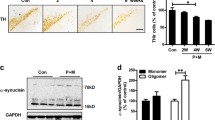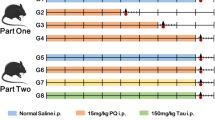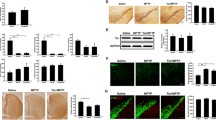Abstract
Beyond nigrostriatal dopaminergic system, the noradrenergic locus coeruleus (LC/NE) neurons are also degenerated in patients with Parkinson’s disease (PD), the second most common neurodegenerative disorder. We previously reported that microglia-mediated neuroinflammation contributes to LC/NE neurodegeneration. The purpose of this study is aimed to test whether taurine, an endogenous amino acid, could be able to protect LC/NE neurons through inhibition of microglial activation using paraquat and maneb-induced mouse PD model. Taurine (150 mg/kg) was administrated (i.p) to mice 30 min prior to paraquat (10 mg/kg) and maneb (30 mg/kg) intoxication for consecutive 6 weeks (twice per week). The results clearly demonstrated that paraquat and maneb co-exposure resulted in loss of tyrosine hydroxylase-positive neurons in the LC in mice, which was significantly ameliorated by taurine. Mechanistically, inhibition of microglia-mediated neuroinflammation contributed to taurine-afforded neuroprotection. Taurine attenuated paraquat and maneb-induced microglial activation and M1 polarization as well as release of proinflammatory cytokines in brainstem of mice. Taurine also abrogated microglial NADPH oxidase activation and oxidative damage in paraquat and maneb-treated mice. Furthermore, inhibition of nuclear factor-κB (NF-κB) but not signal transducers and activators of transcription 1/3 (STAT1/3) signaling pathway participated in taurine-inhibited microglial activation. Collectively, taurine exerted LC/NE neuroprotection against microglia-mediated neurotoxicity. The robust neuroprotective effects of taurine suggest that taurine may be a promising candidate for potential therapy for patients suffering from PD.





Similar content being viewed by others
Change history
13 February 2021
A Correction to this paper has been published: https://doi.org/10.1007/s00726-021-02944-6
References
Agca CA, Tuzcu M, Hayirli A, Sahin K (2014) Taurine ameliorates neuropathy via regulating NF-kappaB and Nrf2/HO-1 signaling cascades in diabetic rats. Food Chem Toxicol 71:116–121. https://doi.org/10.1016/j.fct.2014.05.023
Bing G, Zhang Y, Watanabe Y, McEwen BS, Stone EA (1994) Locus coeruleus lesions potentiate neurotoxic effects of MPTP in dopaminergic neurons of the substantia nigra. Brain Res 668(1–2):261–265. https://doi.org/10.1016/0006-8993(94)90534-7
Block ML, Hong JS (2005) Microglia and inflammation-mediated neurodegeneration: multiple triggers with a common mechanism. Prog Neurobiol 76(2):77–98
Block ML, Zecca L, Hong JS (2007) Microglia-mediated neurotoxicity: uncovering the molecular mechanisms. Nat Rev Neurosci 8(1):57–69. https://doi.org/10.1038/nrn2038
Braak H, Del Tredici K, Rub U, de Vos RA, Jansen Steur EN, Braak E (2003) Staging of brain pathology related to sporadic Parkinson’s disease. Neurobiol Aging 24(2):197–211
Caletti G, Herrmann AP, Pulcinelli RR, Steffens L, Moras AM, Vianna P, Chies JAB, Moura DJ, Barros HMT, Gomez R (2017) Taurine counteracts the neurotoxic effects of streptozotocin-induced diabetes in rats. Amino Acids. https://doi.org/10.1007/s00726-017-2495-1
Choi SH, Aid S, Kim HW, Jackson SH, Bosetti F (2012) Inhibition of NADPH oxidase promotes alternative and anti-inflammatory microglial activation during neuroinflammation. J Neurochem 120(2):292–301. https://doi.org/10.1111/j.1471-4159.2011.07572.x
El Idrissi A, Shen CH, L’Amoreaux WJ (2013) Neuroprotective role of taurine during aging. Amino Acids 45(4):735–750. https://doi.org/10.1007/s00726-013-1544-7
Gao HM, Hong JS (2008) Why neurodegenerative diseases are progressive: uncontrolled inflammation drives disease progression. Trends Immunol 29(8):357–365. https://doi.org/10.1016/j.it.2008.05.002
Grace PM, Shimizu K, Strand KA, Rice KC, Deng G, Watkins LR, Herson PS (2015) (+)-Naltrexone is neuroprotective and promotes alternative activation in the mouse hippocampus after cardiac arrest/cardiopulmonary resuscitation. Brain Behav Immun 48:115–122. https://doi.org/10.1016/j.bbi.2015.03.005
Han Z, Gao LY, Lin YH, Chang L, Wu HY, Luo CX, Zhu DY (2016) Neuroprotection of taurine against reactive oxygen species is associated with inhibiting NADPH oxidases. Eur J Pharmacol 777:129–135. https://doi.org/10.1016/j.ejphar.2016.03.006
Hou L, Zhang C, Wang K, Liu X, Wang H, Che Y, Sun F, Zhou X, Zhao X, Wang Q (2017) Paraquat and maneb co-exposure induces noradrenergic locus coeruleus neurodegeneration through NADPH oxidase-mediated microglial activation. Toxicology 380:1–10
Imamura K, Hishikawa N, Sawada M, Nagatsu T, Yoshida M, Hashizume Y (2003) Distribution of major histocompatibility complex class II-positive microglia and cytokine profile of Parkinson’s disease brains. Acta Neuropathol 106(6):518–526. https://doi.org/10.1007/s00401-003-0766-2
Javed H, Khan A, Vaibhav K, Moshahid Khan M, Ahmad A, Ejaz Ahmad M, Tabassum R, Islam F, Safhi MM (2013) Taurine ameliorates neurobehavioral, neurochemical and immunohistochemical changes in sporadic dementia of Alzheimer’s type (SDAT) caused by intracerebroventricular streptozotocin in rats. Neurol Sci 34(12):2181–2192. https://doi.org/10.1007/s10072-013-1444-3
Jiang L, Chen SH, Chu CH, Wang SJ, Oyarzabal E, Wilson B, Sanders V, Xie K, Wang Q, Hong JS (2015) A novel role of microglial NADPH oxidase in mediating extra-synaptic function of norepinephrine in regulating brain immune homeostasis. Glia 63(6):1057–1072. https://doi.org/10.1002/glia.22801
Junyent F, Utrera J, Romero R, Pallas M, Camins A, Duque D, Auladell C (2009) Prevention of epilepsy by taurine treatments in mice experimental model. J Neurosci Res 87(6):1500–1508. https://doi.org/10.1002/jnr.21950
Kim HY, Kim HV, Yoon JH, Kang BR, Cho SM, Lee S, Kim JY, Kim JW, Cho Y, Woo J, Kim Y (2014) Taurine in drinking water recovers learning and memory in the adult APP/PS1 mouse model of Alzheimer’s disease. Sci Rep 4:7467. https://doi.org/10.1038/srep07467
Lacher SE, Skagen K, Veit J, Dalton R, Woodahl EL (2015) P-glycoprotein transport of neurotoxic pesticides. J Pharmacol Exp Ther 355(1):99–107. https://doi.org/10.1124/jpet.115.226373
Lambeth JD (2004) NOX enzymes and the biology of reactive oxygen. Nat Rev Immunol 4(3):181–189. https://doi.org/10.1038/nri1312
Lee DS, Kwon KH, Cheong SH (2017) Taurine chloramine suppresses LPS-induced neuroinflammatory responses through Nrf2-mediated heme oxygenase-1 expression in mouse BV2 microglial cells. Adv Exp Med Biol 975:131–143. https://doi.org/10.1007/978-94-024-1079-2_12
Li S, Yang L, Zhang Y, Zhang C, Shao J, Liu X, Li Y, Piao F (2017) Taurine ameliorates arsenic-induced apoptosis in the hippocampus of mice through intrinsic pathway. Adv Exp Med Biol 975:183–192. https://doi.org/10.1007/978-94-024-1079-2_16
Liu B, Qin L, Yang SN, Wilson BC, Liu Y, Hong JS (2001) Femtomolar concentrations of dynorphins protect rat mesencephalic dopaminergic neurons against inflammatory damage. J Pharmacol Exp Ther 298(3):1133–1141
Marcinkiewicz J, Kontny E (2014) Taurine and inflammatory diseases. Amino Acids 46(1):7–20. https://doi.org/10.1007/s00726-012-1361-4
Menzie J, Pan C, Prentice H, Wu JY (2014) Taurine and central nervous system disorders. Amino Acids 46(1):31–46. https://doi.org/10.1007/s00726-012-1382-z
O’Byrne MB, Tipton KF (2000) Taurine-induced attenuation of MPP+ neurotoxicity in vitro: a possible role for the GABA(A) subclass of GABA receptors. J Neurochem 74(5):2087–2093
Okura T, Ibe M, Umegaki K, Shinozuka K, Yamada S (2010) Effects of dietary ingredients on function and expression of P-glycoprotein in human intestinal epithelial cells. Biol Pharm Bull 33(2):255–259. https://doi.org/10.1248/bpb.33.255
Olanow CW, Tatton WG (1999) Etiology and pathogenesis of Parkinson’s disease. Annu Rev Neurosci 22:123–144. https://doi.org/10.1146/annurev.neuro.22.1.123
Orihuela R, McPherson CA, Harry GJ (2016) Microglial M1/M2 polarization and metabolic states. Br J Pharmacol 173(4):649–665. https://doi.org/10.1111/bph.13139
Park A, Stacy M (2009) Non-motor symptoms in Parkinson’s disease. J Neurol 256(Suppl 3):293–298. https://doi.org/10.1007/s00415-009-5240-1
Paxinos G, Franklin KBJ (2001) The mouse brain in stereotaxic coordinates, 2nd edn. Academic Press, San Diego
Qian L, Gao X, Pei Z, Wu X, Block M, Wilson B, Hong JS, Flood PM (2007) NADPH oxidase inhibitor DPI is neuroprotective at femtomolar concentrations through inhibition of microglia over-activation. Parkinsonism Relat Disord 13(Suppl 3):S316–S320. https://doi.org/10.1016/S1353-8020(08)70023-3
Qin H, Buckley JA, Li X, Liu Y, Fox TH 3rd, Meares GP, Yu H, Yan Z, Harms AS, Li Y, Standaert DG, Benveniste EN (2016) Inhibition of the JAK/STAT pathway protects against alpha-synuclein-induced neuroinflammation and dopaminergic neurodegeneration. J Neurosci 36(18):5144–5159. https://doi.org/10.1523/JNEUROSCI.4658-15.2016
Reeta KH, Singh D, Gupta YK (2017) Chronic treatment with taurine after intracerebroventricular streptozotocin injection improves cognitive dysfunction in rats by modulating oxidative stress, cholinergic functions and neuroinflammation. Neurochem Int 108:146–156
Sanchez-Padilla J, Guzman JN, Ilijic E, Kondapalli J, Galtieri DJ, Yang B, Schieber S, Oertel W, Wokosin D, Schumacker PT, Surmeier DJ (2014) Mitochondrial oxidant stress in locus coeruleus is regulated by activity and nitric oxide synthase. Nat Neurosci 17(6):832–840. https://doi.org/10.1038/nn.3717
Shimizu K, Ohtaki K, Matsubara K, Aoyama K, Uezono T, Saito O, Suno M, Ogawa K, Hayase N, Kimura K, Shiono H (2001) Carrier-mediated processes in blood–brain barrier penetration and neural uptake of paraquat. Brain Res 906(1–2):135–142
Silva R, Sousa E, Carmo H, Palmeira A, Barbosa DJ, Gameiro M, Pinto M, Bastos Mde L, Remiao F (2014) Induction and activation of P-glycoprotein by dihydroxylated xanthones protect against the cytotoxicity of the P-glycoprotein substrate paraquat. Arch Toxicol 88(4):937–951. https://doi.org/10.1007/s00204-014-1193-y
Surmeier DJ, Guzman JN, Sanchez-Padilla J (2010) Calcium, cellular aging, and selective neuronal vulnerability in Parkinson’s disease. Cell Calcium 47(2):175–182. https://doi.org/10.1016/j.ceca.2009.12.003
Taetzsch T, Levesque S, McGraw C, Brookins S, Luqa R, Bonini MG, Mason RP, Oh U, Block ML (2015) Redox regulation of NF-kappaB p50 and M1 polarization in microglia. Glia 63(3):423–440. https://doi.org/10.1002/glia.22762
Taylor TN, Alter SP, Wang M, Goldstein DS, Miller GW (2014) Reduced vesicular storage of catecholamines causes progressive degeneration in the locus ceruleus. Neuropharmacology 76 Pt A:97–105. https://doi.org/10.1016/j.neuropharm.2013.08.033
Uchida K (2003) 4-Hydroxy-2-nonenal: a product and mediator of oxidative stress. Prog Lipid Res 42(4):318–343
Wang Q, Shin EJ, Nguyen XK, Li Q, Bach JH, Bing G, Kim WK, Kim HC, Hong JS (2012) Endogenous dynorphin protects against neurotoxin-elicited nigrostriatal dopaminergic neuron damage and motor deficits in mice. J Neuroinflammation 9:124. https://doi.org/10.1186/1742-2094-9-124
Wang Q, Chu CH, Oyarzabal E, Jiang L, Chen SH, Wilson B, Qian L, Hong JS (2014a) Subpicomolar diphenyleneiodonium inhibits microglial NADPH oxidase with high specificity and shows great potential as a therapeutic agent for neurodegenerative diseases. Glia 62(12):2034–2043. https://doi.org/10.1002/glia.22724
Wang Q, Chu CH, Qian L, Chen SH, Wilson B, Oyarzabal E, Jiang L, Ali S, Robinson B, Kim HC, Hong JS (2014b) Substance P exacerbates dopaminergic neurodegeneration through neurokinin-1 receptor-independent activation of microglial NADPH oxidase. J Neurosci 34(37):12490–12503. https://doi.org/10.1523/JNEUROSCI.2238-14.2014
Wang Q, Qian L, Chen SH, Chu CH, Wilson B, Oyarzabal E, Ali S, Robinson B, Rao D, Hong JS (2015) Post-treatment with an ultra-low dose of NADPH oxidase inhibitor diphenyleneiodonium attenuates disease progression in multiple Parkinson’s disease models. Brain 138(Pt 5):1247–1262. https://doi.org/10.1093/brain/awv034
Yao N, Wu Y, Zhou Y, Ju L, Liu Y, Ju R, Duan D, Xu Q (2015) Lesion of the locus coeruleus aggravates dopaminergic neuron degeneration by modulating microglial function in mouse models of Parkinson’s disease. Brain Res 1625:255–274. https://doi.org/10.1016/j.brainres.2015.08.032
Zarow C, Lyness SA, Mortimer JA, Chui HC (2003) Neuronal loss is greater in the locus coeruleus than nucleus basalis and substantia nigra in Alzheimer and Parkinson diseases. Arch Neurol 60(3):337–341. https://doi.org/10.1001/archneur.60.3.337
Zhang F, Qian L, Flood PM, Shi JS, Hong JS, Gao HM (2010) Inhibition of IkappaB kinase-beta protects dopamine neurons against lipopolysaccharide-induced neurotoxicity. J Pharmacol Exp Ther 333(3):822–833. https://doi.org/10.1124/jpet.110.165829
Zhang L, Yuan Y, Tong Q, Jiang S, Xu Q, Ding J, Zhang R, Zhang K (2016a) Reduced plasma taurine level in Parkinson’s disease: association with motor severity and levodopa treatment. Int J Neurosci 126(7):630–636. https://doi.org/10.3109/00207454.2015.1051046
Zhang Y, Li D, Li H, Hou D, Hou J (2016b) Taurine pretreatment prevents isoflurane-induced cognitive impairment by inhibiting er stress-mediated activation of apoptosis pathways in the hippocampus in aged rats. Neurochem Res 41(10):2517–2525. https://doi.org/10.1007/s11064-016-1963-4
Acknowledgements
This work was supported by “QiZhen” Talent Project of Dalian Medical University (No. 201122), Liaoning BaiQianWan Talents Program (No. [2017]90) and Program for Liaoning Innovative Talents in University.
Author information
Authors and Affiliations
Corresponding author
Ethics declarations
Conflict of interest
The authors declare no conflict of interest.
Research involving human participants and/or animals
All animal procedures and their care were carried out in accordance the National Institute of Health Guide for the Care and Use of Laboratory Animals and were approved by the Institutional Animal Care and Use Committee of Dalian Medical University.
Additional information
Handling Editor: T. Harkany.
Rights and permissions
About this article
Cite this article
Hou, L., Che, Y., Sun, F. et al. Taurine protects noradrenergic locus coeruleus neurons in a mouse Parkinson’s disease model by inhibiting microglial M1 polarization. Amino Acids 50, 547–556 (2018). https://doi.org/10.1007/s00726-018-2547-1
Received:
Accepted:
Published:
Issue Date:
DOI: https://doi.org/10.1007/s00726-018-2547-1




